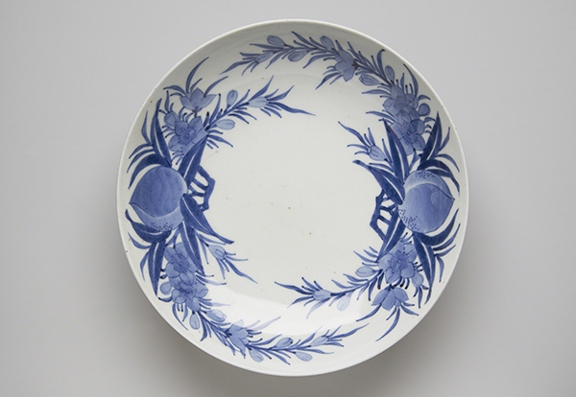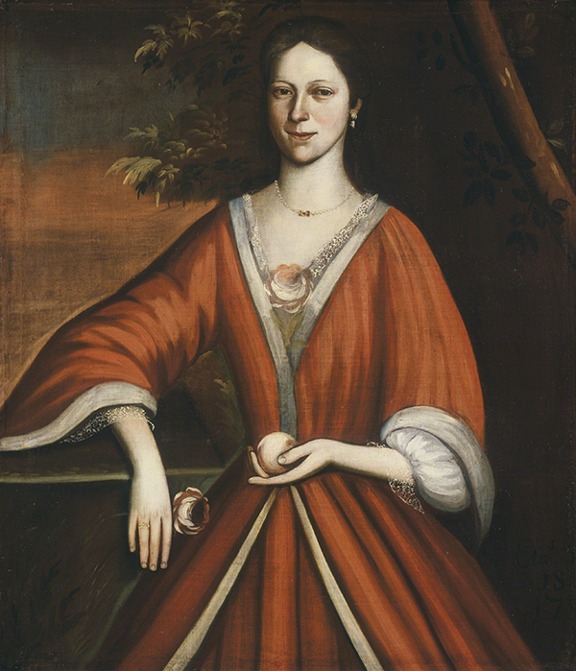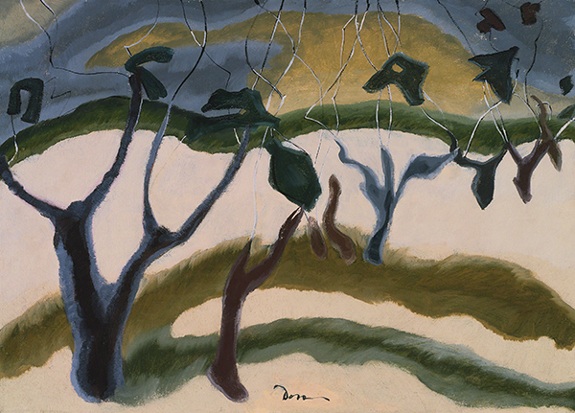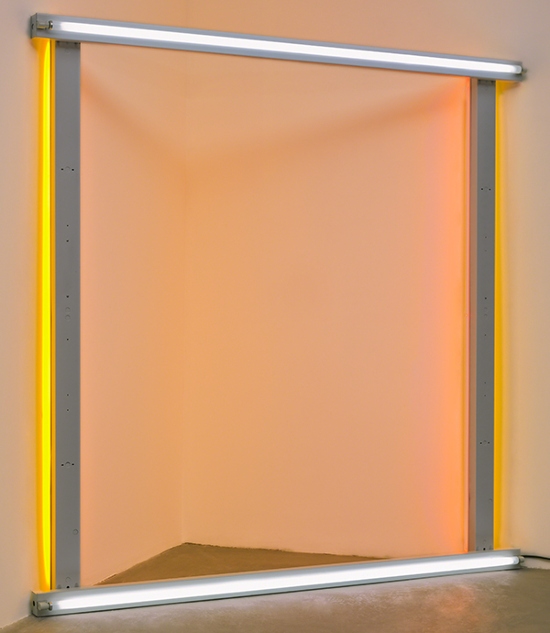Art for National Peach Month 2024
August was first declared National Peach Month in the United States in 1982. Since August is the month when peaches are supposed to be at their peak ripeness, let’s look at some works of art that reference the fruit in a variety of ways.
 |
| Unknown artist, Edo Period, Japan, Dish with Peach Pattern, 1700s. Nabeshima ware porcelain with cobalt blue underglaze decoration, width: 8" (20.3 cm). © 2024 Brooklyn Museum. (BMA-5443B) |
The porcelain technique was of extraordinary importance in the development of Edo period ceramics. The discovery of kaolin (porcelain clay) in Bizen province in the early 1600s, combined with Chinese techniques imported via Korean ceramic artists who immigrated to Japan, led to a flourishing in porcelain production.
The most extensive network of kilns for porcelain production was in the Arita region of Bizen. By the late 1600s, many of these wares were exported to Europe and ended up in royal collections throughout the West. This led to Arita wares heavily influencing fledgling European porcelain makers starting in the 1700s.
Nabeshima ware was produced at the Ōkawachi kilns after the factory relocted to Arita province in 1675. The high-quality porcelain was originally made for the Nabeshima clan. The designs reflected decoration seen in lacquer work and kimonos influenced by painter/decorator Ogata Korin (1658–1716) and other yamato-e artists. The most famous Nabeshima wares were produced in the late 1600s and 1700s. A conservative ware, it was not exported to the West. This plate, Dish with Peach Pattern, mimics the popular blue-and-white wares perfected in Ming dynasty (1368–1644) China with its underglaze cobalt blue decoration. Blue-and-white ware became enormously popular after their importation to Japan during the Muromachi period (1392–1573).
 |
| Attributed to Nehemiah Partridge (1683–ca. 1737, U.S.), Wyntje (Lavinia) van Vechten, 1720. Oil on canvas, 40 ⅛" x 34 ½" (102 x 87.8 cm). © 2024 Brooklyn Museum. (BMA-563) |
Portraiture was almost the only genre of painting commissioned by well-to-do American colonists. It afforded them the opportunity to display their status not only in the fact that they could afford to commission a portrait, but also with the accoutrements of wealth such as dress and possessions depicted in the portrait. It was also part of the soon-to-be thriving tradition of the itinerant, self-trained painter (limner)—a feature of American painting that endured well into the 1800s.
Limner portrait painters had stock poses and body types for male and female portraits that they gleaned from British prints of portraits. Without art lessons in anatomy, depiction of logical space, and single-source lighting, their efforts were often awkward. Limner portraits are characterized in extreme attention to detail, although bodies often lack the volumetric quality of surrounding objects. In the tradition of European portraits, the body is shown surrounded by the trappings of a life of affluence. The naively rendered background landscapes reflect the style of painted overmantels from the colonial period, the first landscapes in American painting.
In the early 1700s, several limners were active in the Hudson Valley from New York City to Albany. They painted portraits of the wealthy patroon (landowner) families, and have come to be called Patroon Painters. They relied heavily on mezzotint prints of European portraiture from the Baroque period, which ultimately became the only art from on which patrons based their stylistic preferences.
Although New Amsterdam became New York in 1665 when the Dutch ceded control of the city to the British, the Dutch culture in New York persisted in the Hudson River Valley until the 1800s. Born in Portsmouth, New Hampshire, Nehemiah Partridge was a limner active in the Albany, New York, area from 1718 to 1721. He returned to Albany around 1724 before moving to Boston, Massachusetts. Most of his portraits were derived from mezzotint copies of primarily late Renaissance/early Baroque British artists. The result, therefore, is a certain stiffness of pose, a naïve treatment of surfaces such as the omnipresent highlight lines on the crest of folds in the clothing, and the rather frozen, self-conscious facial features.
This portrait of an affluent young Dutch woman, Wyntje (Lavinia) van Vechten, with its failed attempt at a casually elegant pose, reveals traits common to all portraiture of the time. This includes the vague landscape background and the sitter with objects that symbolize her character. The two roses symbolize the young woman's purity and innocence, while the ripe peach is a symbol of good health. This may indicate that the portrait was either a betrothal piece or celebrated the young woman's wedding.
 |
| Arthur Dove (1880–1946, U.S.), Electric Peach Orchard, 1935. Oil on canvas, 20 3⁄16" x 28" (51.3 x 71.2 cm). The Phillips Collection, Washington, DC. © 2024 Artist or Estate of Artist. (PC-100) |
During the 1930s, Arthur Dove's work tended more toward recognizable subject matter, at least by title. Dove observed his immediate surroundings such as fields in this peach orchard, integrating their abstracted forms into his paintings. He painted Electric Peach Orchard in Geneva, New York, where he moved in 1933 to escape the pressures of New York City. This painting displays Dove’s fascination with what he perceived as the underlying, often unseen, mysteries of nature. His quest to give visual form to mystical forces is similar to the Social Realist watercolor painter Charles Burchfield (1893–1967).
In Electric Peach Orchard, Dove transforms a diagonal row of trees into a series of writhing forms whose branches are linked by agitated, tendril-like lines that are literal representations of electric currents. These lines, which extend from the sky into the trees, also signify an interaction between the land and the atmosphere, perhaps the trees’ absorption of light or moisture. Dove, who emphasized creating visual equivalents for nature’s hidden energies, may also have been influenced by other mystical theories from the 1800s that suggested electricity was physical proof of a fourth dimension and an unseen spiritual world.
While many Western modernist art movements in the early 1900s such as Cubism, Futurism, and Constructivism were inspired by increased industrialization in the West, some modernist artists sought solace in the natural world. Artists like Dove did this while incorporating an abstractionist visual vocabulary. Dove was born in Canandaigua, New York. While a young man, Dove befriended a neighboring naturalist, Newton Weatherby, who encouraged his love of nature. Weatherby, as an amateur artist, provided Dove with his earliest painting lessons.
Although Dove's father wanted him to study law, Dove instead settled for a career as a graphic illustrator in 1903. His acquaintance with Ash Can School painters John Sloan (1871–1951) and George Luks (1867–1933) convinced him to take up painting. He honed his painting ability for fifteen months in southern France in 1908, where he was exposed to the modernist experiments of Fauvism, Cubism, and early American modernists such as Max Weber (1881–1961). Dove's style at the time went from Impressionist to a manner of Fauvism.
After exposure to the American modernists at Alfred Steiglitz's (1864–1946) Gallery 291 in New York City, Dove sought to discard any semblance of figure, narrative, and setting even in the titles for his work between 1910 and 1912. He replaced these with pattern, saturated color shapes, and simplified contours. He was the first American artist to emphasize completely nonobjective abstraction in his body of work.
By the 1920s, Dove was still influenced by Cubism and by the abstraction of Vasily Kandinsky (1866–1944). He greatly appreciated Kandinsky's theories about the connection between painting and music, which he began to link to American jazz music. From 1930 onward, during the Great Depression, abstraction fell in appreciation among American patrons. In his later years, Dove lived on a houseboat on Long Island Sound, which enabled him to be close to nature that he loved to paint.
 |
| Dan Flavin (1933–1996, U.S.), untitled (to the “innovator” of Wheeling Peachblow), 1968. Fluorescent light and metal frame, 96 7⁄16" x 96 3⁄16" x 5 11⁄16" (245 x 244.3 x 14.5 cm). The Museum of Modern Art, New York. © 2024 Stephan Flavin / Artists Rights Society (ARS), New York. (MOMA-S0782flars) |
In 1961, while working as a guard at the Natural History Museum in New York, Dan Flavin began making sketches for sculptures that included electric lights. He translated those sketches into assemblages of works he termed "icons," in which lights were juxtaposed with monochromatic canvases. By 1963, Flavin had removed the canvas completely and began to work with fluorescent tubes that would become the hallmark of his body of work. In 1968, Flavin created a room-sized, ultraviolet light installation at Documenta 4 in Kassel, Germany. The artist did not call his fluorescent works “sculpture” but rather “situations.” This took into account not only the use of unconventional materials, but also the resulting change in ambient lighting surrounding his installations.
Untitled (to the “innovator” of Wheeling Peachblow), shown here, is installed in a corner of a room, not a typical setting for a sculpture. The piece extends into three-dimensions, not only in its physical straddling the space but also the light reaching out into the surrounding space. The result visually changes the physical structure of the room. The work is named after a vintage type of glass from Wheeling, West Virginia, called “peachblow.” It was given this name because the peach color resembled a peach-colored Chinese porcelain. Flavin was an avid appreciator of vintage American glass.
Since the early 1900s, the use of light in or as a work of art has periodically been explored. Light was usually used in limited ways as devices were programmed to produce shifting patterns of colored light. These experiments originated at Bauhaus during the 1920s in the motion and light experiments of László Moholy-Nagy (1895–1946). In the United States, the inventor of the color organ, Thomas Wilfred (1889–1968), created early experimental combinations of light and color. The late 1960s saw a revival of interest in the use of light as a stand-alone medium, a logical result of its inclusion as a component in installations, performances, and videos combined with action and sound.
Flavin was born in Jamaica, New York. He studied art through the Maryland Extension Program from 1954 to 1955 while serving in the Air Force in Korea. Returning to New York, he studied at the Hans Hofmann School of Fine Arts, studied art history at the New School, and took drawing and painting courses at Columbia University. His work of the late 1950s included mixed-media collages and paintings that owed a debt to Abstract Expressionism.


Comments